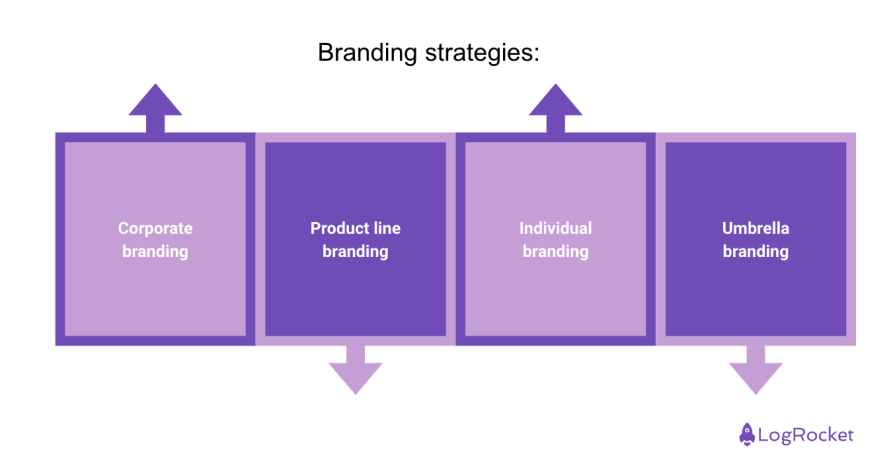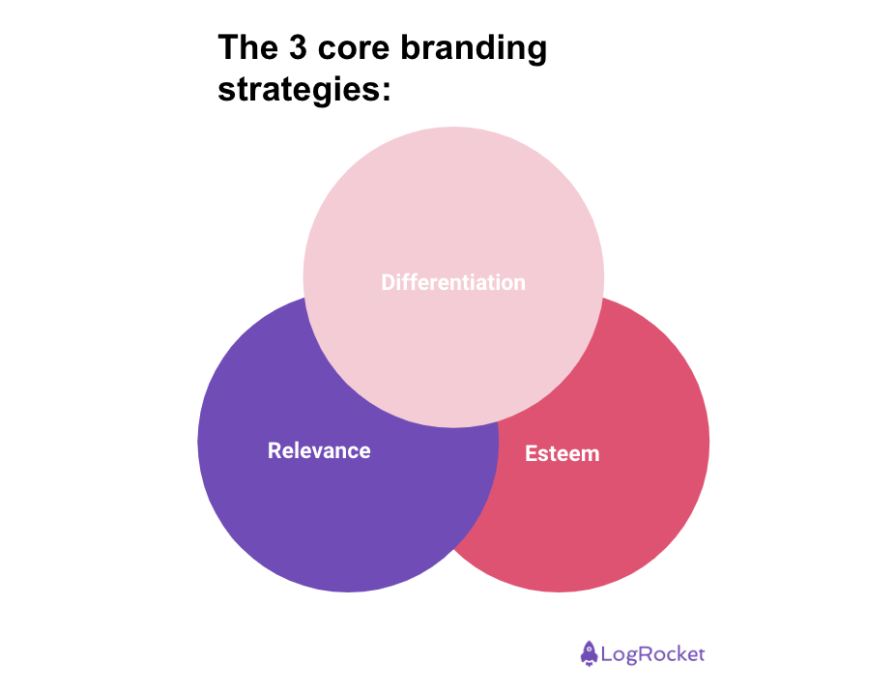Brand strategy is one of the most underestimated forces that shapes the trajectory of your products and services. When planned and executed well, it can significantly uplift your business and create long-term value with your customers. How can you create an effective brand strategy?

Think about your everyday life and all the things you buy — food, groceries, clothes, cars, experiences. When buying these products and services, why do you prefer certain brands over others? Many of these are probably very similar and built with the same technology, but the reason you buy something depends on how a brand makes you feel.
There’s something about the brand that you can relate to. It’s true that brands need to deliver on quality and develop trust with customers for long-term retention, but a company’s brand value is what will encourage its potential customers to try out your products/services in the first place.
A brand is what a company stands for — the values and principles the business is built on and the mission through which the business attains to serve its customers. A brand strategy is a comprehensive marketing plan developed to build a memorable impression in the minds of potential customers. It not only reflects a company’s values, vision, mission, and personality, it also helps define the target audience you want to engage with.
A brand strategy outlines how to position products and services in the market, considering the dynamic variables of the environment. It also helps differentiate your business from competitors. Especially for product managers, it serves as a roadmap for long-term success, fostering brand loyalty, and driving business growth.
The brand strategy will guide every aspect of product development, from prioritizing features, to designing and building them, to marketing and distribution channels. This will ensure consistency and alignment with your brand identity as well as your business objectives.
Product branding plays a pivotal role in shaping product strategy by influencing how a product is perceived, positioned, and differentiated in the marketplace. A strong brand communicates the unique value proposition of the product, resonates with your target audience, and establishes a distinct identity that sets your business apart from competitors. This, in turn, informs all product decisions and helps the team bring true customer value to market:

When the focus is on establishing a strong brand identity and reputation for the entire company, corporate branding strategies are used. Take Apple, a powerful corporate brand synonymous with design excellence, quality, and innovation. It represents a cohesive brand image, encompassing the company’s values, culture, and commitment to customer satisfaction, that extends beyond its suite of products — watches, phones, tablets, computers, earphones, etc.
When the focus is on creating distinct brands for different product lines within a company’s portfolio, product line branding strategies are used. An example of this would be Procter and Gamble (P&G), a consumer goods company that owns multiple product lines, each with its own brand identity. Their product line brands include companies like:
When the focus is on enabling each product or service to have its own separate brand within a company’s portfolio, individual branding strategies are used. In this case, you can think of Unilever, a multinational consumer goods company, that owns over 400 brands, including Dove, Lipton, and Ben and Jerry’s. These products are marketed as individual brands with their own brand identity, messaging, market positioning, and without any direct acknowledgement of the parent company
When the focus is on using a single brand to encompass multiple related products or services offered by a company, umbrella branding strategies are used. This is also known as family branding or branded house strategy. BMW, a luxury automobile company, offers a wide range of products under the BMW brand, including a diverse variety of cars, motorcycles, auto insurance, and auto services. BMW leverages its brand loyalty with the one brand across its diverse portfolio of products and services.
A comprehensive brand strategy needs to articulate a clear company vision, mission, and a set of values that can be used to establish a strong foundation of building meaningful connections with your target audience, fostering brand loyalty, and driving long-term customer value. These should collectively define your brand’s identity, purpose, and direction. Let’s look at each of these key components in more detail:
You can establish a strong competitive brand and foster lasting connections with your target audience by effectively differentiating your brand, ensuring its relevance to potential customers, and building esteem through user trust and credibility. These three core branding strategies — differentiation, relevance, and esteem — can work well together to create a distinctive, appealing, and reputed brand in the market:

This strategy involves creating a competitive position for your brand among other similar brands or products in the market. To differentiate your brand, highlight the unique attributes that can create a distinct memorable experience in the minds of potential customers.
This can include features, benefits, brand values, and/or experiences that are perceived valuable by your target audience. You can create competitive advantage and brand preference by providing superior quality and exceptional customer service, prioritizing product innovation, and creating a unique fun brand personality.
The term “relevance” here refers to the extent to which your brand meets the needs, wants, and preferences of your target audience. A relevant brand will resonate with potential customers by offering products and services that are aligned with their values, lifestyles, and aspirations.
Relevance needs to be maintained over time, and to do this, you must stay in tune with customer trends, market dynamics, cultural shifts, etc. and adapt your brand messaging, product offerings, and leverage emerging technologies accordingly. By staying relevant, you can be a top-of-mind brand.
Your brand’s perceived reputation, credibility, and quality is important to maintain long-term connections with your target audience. A brand with high esteem is held in high regard, commanding respect and trust from its customers.
Cultivating a strong brand identity and consistently meeting or exceeding customer expectations are essential for building and maintaining a brand’s esteem over time. Positive brand associations, word-of-mouth referrals, media endorsements and coverage can enhance a brand’s esteem in the minds of potential customers and can drive business growth.
A brand strategy can become your most powerful asset, encompassing the core values of your company and paving the path for long-term business sustainability. Use this step-by-step guide to develop an effective brand strategy that resonates with your target audience.
Understand the market and the dynamic variables that can impact your product offerings, industry trends, and competitive landscape. Gather insights on user needs, pain points, behaviors, and preferences. Analyze existing data and conduct surveys, interviews and focus groups with current and potential customers to obtain both qualitative and quantitative information.
This should lay the foundation for why your company should exist.
Establish your company’s vision, mission, and core values. Answer why your business exists and what problem(s) it aims to solve. Clarify what your brand stands for and what impact it seeks to make in the world.
Create written documents for your brand components in collaboration with your team members. Your brand is as powerful as the belief you and your team members have in it.
Develop detailed buyer personas that represent your ideal customers. Consider the demographics, psychographics, user behaviors, interests, and pain points you’re aiming to elevate for your potential customers.
Understand where they spend their time, how they consume information, and what influences their buying decisions. Assess the digital channels that are most effective for communication and engagement.
Identify both direct and indirect competitors of your product offerings. Create a SWOT analysis where strengths, weaknesses, opportunities, and threats are analyzed.
Understand how these competitors position themselves in the marketplace and differentiate their brands. Learn what kind of product/service, branding, marketing, and communication strategies your competitors are adopting.
Determine how you want your brand to be perceived in the minds of potential customers relative to your competitors. Establish your unique value proposition and key differentiators that will set your brand apart from the rest of your competitors.
Position your brand based on factors such as price, quality, product innovation, customer service, and brand values. You want your potential customers to feel like they resonate with your brand.
Create a unique identity that will help potential customers remember your brand easily. Leverage visual elements such as logo, colors, typography, and imagery that reflect your brand’s personality and values.
Develop brand guidelines to ensure that there is consistency in branding across all touchpoints. Ensure that all employees are equipped with these assets and know how to use them effectively.
Develop clear and compelling messaging that communicates your company’s vision, mission, unique value proposition, and product/service offerings. Define your brand’s tone of voice, language, messaging architecture and styles for different audiences and communication channels.
Keep your messaging simple, concise, and straightforward. You can even try some A/B testing to understand what kind of messaging works best.
Create a seamless and consistent user experience for potential customers that engage with your brand, across all touchpoints. Be it your product, service, marketing campaign, customer interaction, the brand experience should feel delightful.
Ensure that the brand experience aligns with your brand identity, core values, and promise(s) made to customers. You want customers to keep coming back and having positive experiences and interactions with your brand every time.
Once you’ve figured out which brand strategy or a combination of strategies you’re going to adopt, it’s time to execute. Develop a marketing plan that outlines how you will reach and engage your target audience.
Utilize various channels such as social media, content marketing, advertising, public relations, and events to build brand awareness and bring visibility to your product and service offerings.
It’s crucial to monitor the performance and effectiveness of your brand strategy continually. Track key performance indicators such as brand awareness, brand perception, customer satisfaction, market share, and business revenue.
Use data and analytics to map patterns and trends that are impacting your brand strategy, gather insights from various sources internally and externally, make adjustments and adapt as needed.
Many companies have adopted successful brand strategies. These brands have been able to leverage purpose-driven messaging, customer engagement, product innovation, and a compelling and consistent brand experience to create meaningful connections with their target audience.
This was one of the most iconic examples of brand strategy in the financial services industry. Launched in 1997, the campaign aimed to shift Mastercard’s brand perception from being a mere payment card to a provider of priceless experiences and moments.
This centered around the idea that some things in life are truly priceless, emphasizing emotional connections and memorable experiences over material possessions. The campaign resonated with potential customers by tapping into universal human emotions, showcasing relatable heartwarming and humorous moments.
Nike’s powerful brand strategy focuses on honoring athletes instead of just selling shoes and activewear. The brand partners with elite athletes from various sports, honoring them as inspirational individuals who embody their brand values of perseverance, determination, and excellence.
By celebrating the achievements and stories of athletes, Nike cultivates a powerful emotional connection with potential customers, driving brand loyalty and reinforcing its status as a leading sports footwear and apparel company. Nike also actively engages with communities to promote sports participation, contributing to positive brand reputation.
Dove positions itself as a champion of body positivity and self-confidence. Its brand strategy is based on the values of authenticity, diversity, and inclusivity. The “real beauty” campaign launched in 2004 along with projects like the “self-esteem project,” challenged traditional beauty standards by celebrating women of all shapes, sizes, ages, and ethnicities.
This campaign struck a chord with customers world-wide, driving sales growth and brand loyalty, while sparking important conversations about projected beauty and self-image in the society.
Successful brand strategies are characterized by authenticity, relevance, and consistency, as well as a deep understanding of customer needs and market dynamics. You can create compelling brand experiences that resonate with your target audience and inspire brand advocacy by staying true to your brand identity, delivering exceptional value to customers, and continuously adapting to changes in the marketplace.
Ultimately, crafting a brand strategy is an ongoing journey that requires continuous refinement and adaptation to stay competitive and relevant in today’s dynamic business landscape.
Featured image source: IconScout

LogRocket identifies friction points in the user experience so you can make informed decisions about product and design changes that must happen to hit your goals.
With LogRocket, you can understand the scope of the issues affecting your product and prioritize the changes that need to be made. LogRocket simplifies workflows by allowing Engineering, Product, UX, and Design teams to work from the same data as you, eliminating any confusion about what needs to be done.
Get your teams on the same page — try LogRocket today.

A practical framework for PMs to use AI in ideation without sacrificing judgment, strategy, or decision quality.

A practical five minute revenue estimation method to help product managers compare ideas, drop low impact features, and prioritize smarter.

A practical guide for PMs who want to stop being bottlenecks, delegate smarter, and lead teams effectively with a clear ownership framework.

Stop letting unreliable data block features. Treat data as inventory to track quality, ownership, and ship with confidence.